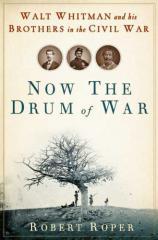Now the Drum of War: Walt Whitman and His Brothers in the Civil War
Review
Now the Drum of War: Walt Whitman and His Brothers in the Civil War
Do our kids learn anything about Walt Whitman in school these
days? Do they read any of the work of our nation’s greatest
poet? Sadly, these are questions worth asking.
A sizeable library of books on Whitman has accumulated since his
death in 1892. He continues to provide grist for the lit-crit mills
and the doctoral thesis industry. For those curious about
Whitman’s life or just enthralled by his wide-ranging poetic
flights, there is a lot out there.
Journalist, historian and fiction writer Robert Roper has taken
a slightly different tack in NOW THE DRUM OF WAR. While
concentrating on the poet’s well-known service as a sort of
unofficial visiting nurse in the military hospitals around
Washington during the Civil War, he also places Whitman within his
family situation --- his aging mother back in Brooklyn, his six
siblings, his early careers as house builder and journalist, and
his once glossed over but now openly acknowledged identity as an
open homosexual.
Roper’s book is not a straightaway biography. It virtually
ignores Whitman’s childhood and devotes almost as much
attention to his heroic soldier-brother George as it does to Walt
himself. It is grounded largely in family letters, in Walt’s
own personal notebooks and in reminiscences of those who knew him
both at home and in the military hospitals and camps. Roper sees
him as “the war’s most knowledgeable
noncombatant.”
Walt Whitman initially went south to visit George after the
bloody battle of Fredericksburg, just one of a long string of major
battles in which George performed heroic service under hails of
shot and shell, while sustaining only one relatively minor wound.
Through acquaintances in Washington, Walt was able to find lodging
and part-time government work that left him ample leisure to carry
out his real mission of visiting the wounded laden with small
articles, food items and words of comfort.
Roper makes clear that Whitman also saw these injured young men
as raw material for his poetry. He gives us a goodly amount of
analysis of the poems, showing how many of them reflect places
Whitman had seen and men Whitman came to know in his hospital
rounds. The author is candid too about the obvious sexual
attraction that Whitman felt toward many of the soldiers he
comforted.
His brother and his elderly mother were both uncomprehending of
his poetic gifts, but both loved him and cared for him assiduously
by letter. He was, says Roper, his family’s father figure.
George Whitman could not make heads or tails of LEAVES OF GRASS
when that epoch-making collection of poems first appeared, and Mrs.
Whitman compared her son’s book ruefully with Longfellow ---
well, if “Hiawatha” is poetry, I guess his is too.
Roper’s mining of family letters and journals gives us a
good idea of what life was like both at home and in the army camps
during the war. Typical of Roper’s lack of interest in
standard biographical detail is his dismissal in one sentence of
the famous incident when a minor government official got Whitman
fired from his Washington job after finding and perusing a copy of
LEAVES OF GRASS in Walt’s office desk.
Roper’s obvious interest in George also leads to a fair
amount of discourse about Civil War battle strategies and campaign
tactics. This is perhaps interesting up to a point, but it is
easily available in quantity elsewhere and seems irrelevant to his
book’s main purpose. That complaint aside, NOW THE DRUM OF
WAR provides a valuable portrait of Walt Whitman as both Civil War
bard and family man. He was, as one hospital observer put it,
“an odd-looking genius.”
Happily, Roper retains the picturesque odd spellings and halting
grammar of his original sources. But oddly, the book has no table
of contents, and his 29 chapters bear no titles --- merely
numbers.
Reviewed by Robert Finn (Robertfinn@aol.com) on January 13, 2011
Now the Drum of War: Walt Whitman and His Brothers in the Civil War
- Publication Date: October 28, 2008
- Genres: History, Nonfiction
- Hardcover: 432 pages
- Publisher: Walker & Company
- ISBN-10: 0802715532
- ISBN-13: 9780802715531



